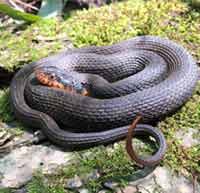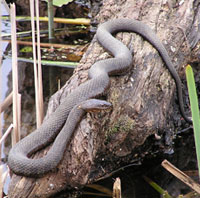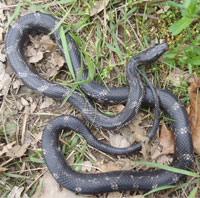
Common Gartersnake Snakes are misunderstood animals that serve as an important component of many types of ecosystems.
All snakes are reptiles. Reptiles are ectothermic, which means they obtain body heat from their surroundings (also called cold-blooded). They bask in the sun to warm and seek shade to cool. They tend to be more active during the day in spring and fall, and more active early morning and evening during the heat of summer.
Many people have a fear of snakes and snakebites. Most snakebites are a result of someone trying to move a snake by accidentally stepping on one. Bites from venomous snakes are very rare in Indiana.
General Characteristics
Common Gartersnake
Indiana is home to 32 native snake species of which only four are venomous.
Snake physical characteristics:
- Lack limbs
- Covered in scales
- Have no moveable eyelids
- Elongated body with specialized scales on the belly (scutes)
- No external ear openings, but can hear some sounds through vibrations of bones in the jaw

Copperbelly
Snake behavioral characteristics:
- Snakes flick their tongue in order to “taste” the air and ground. Particles picked up by the tongue are processed through an organ in the roof of their mouth called the Jacobson’s organ.
- Air temperature is the main factor in snake activity. They control their body temperature by basking in the sun.
- Snakes hibernate from late fall through early spring.
Venomous snake species in Indiana:
- Copperhead - Only found in southern half of the state.
- Cottonmouth - State Endangered - Only found in one small area in southwestern Indiana.
- Eastern Massasauga Rattlesnake - Federally Threatened - Northern third of Indiana.
- Timber Rattlesnake - State Endangered - South central Indiana.
Reproduction
Snakes mate in the spring after they emerge from hibernation or in late-summer before returning to hibernation. Snakes can produce offspring in three ways:
- Oviparous – egg laying. Young receive nutrients only from a yolk sac.
- Viviparous – females gives birth to live young. Young receive nutrients solely, or in part, from the mother.
- Ovoviviparous – females give birth to live young. Embryos receive nutrients only from a yolk sac.
In both viviparous and ovoviviparous species, the eggs lack a true shell. Instead, the young develop within a sac-like membrane inside the mother. Young of oviparous species have a leathery, flexible shell. Females will lay eggs in leaf litter, rotten logs and mulch piles, or underground.
Food habits
The diet of snakes can vary widely depending on availability and location, but all snakes are carnivores. Here are some common items in snake’s diets: 
Northern Watersnake
- Insects
- Rodents (including mice and rats)
- Frogs
- Fish
- Other snakes
- Salamanders
- Birds
- Slugs
Snakes swallow their food whole and have flexible jaws and joints in their skulls, which allow them to consume larger prey.
What eats a snake?
Snakes are preyed upon by many animals including:
- Mammals – raccoons, coyotes, cats, etc.
- Birds - hawks, owls
- Other snakes
Why are Snakes Important for Ecosystems?
- Without snakes, the ecosystem could not survive. Snakes are important food sources for many animals, in turn, they also prey on animals and keep populations in check.
- Snakes are predators — they act as pest control (slugs, insects, mice, etc.)
- When a snake sheds its skin it puts nutrients back into the soil.
Threats
The biggest threats to snake populations are habitat loss, persecution by humans, overuse of pesticides, and collection of wild snakes by hobbyists and reptile dealers.
REMEMBER: Most snakes are killed out of fear.
If you leave a snake alone, it will leave you alone. When a snake bites a person, it does so in self-defense.

